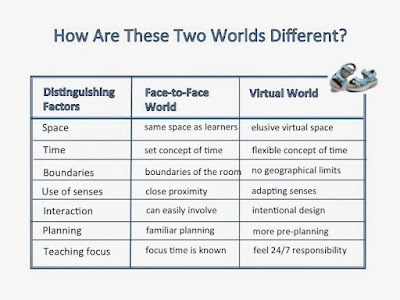Online teaching and learning should be an experience where
presence is felt by both instructors and learners. How is presence created?
The fourth step is CONSIDER THE PSYCHOLOGICAL AND EMOTIONAL. Designing for
online learning has to do with our senses and perceptions (remember the
Differences Chart) and this requires that we learn to adjust our senses and
perceptions to these new ways of reaching out to our students (after all,
perceptions drive our thinking.) Think carefully about this - what we’re doing
is appealing to our students psychologically and emotionally, as well as
cognitively, and creating an illusion of presence. We’re not “really” present
with them (nor they with us) but want to make them think we are - that we’re
all together in the same virtual space.
Reference
Lehman, R. M., & Conceição, S. C. (2010). Creating a Sense of Presence in Online Teaching: How to “Be There” for Distance Learners. Jossey-Bass.













